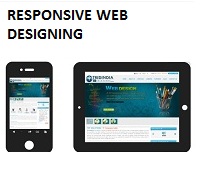If we look at the history of responsive web designing, the first reference to it has been observed in Ethan Marcotte’s article, “A List Apart”, and later elaborated upon in his book “Responsive Web Design” in 2011. Ever since then, the concept has been becoming increasingly popular amongst web enthusiasts. While Mashable has termed the year 2013 as the “Year of Responsive Web Design”, the internet is flooded with best practices and ready reckoners for the same. So, is responsive web designing really the future? Let us attempt to look at it from an unbiased perspective.
What Responsive Designs are all about?
Based on viewability and adaptation to different screen sizes, web designs have been broadly classified into Standard, Adaptive and Responsive. Standard Web Designs are specifically designed with one fixed width for viewing through a browser on a standard sized computer, while Adaptive Web Designs are meant for a specified number of screen sizes with those many number of width layouts for each screen size. Essentially, both standard as well as adaptive web designs have either single or multiple fixed width layouts. Responsive web design offers a radical shift in this context, with one fluid layout that can adapt to all screen sizes as well as screen resolutions. In fact, responsive web design offers a customized user experience across a wide range of devices right from standard PCs to smartphones to tablets and so on. This is achieved by means of using the fluid grid concept, media queries with simultaneously different CSS styles and flexible images.
The Bright Side
The concept certainly is innovative and has a sizeable list of advantages associated with it:
1. Surge of Smartphones and Tablets: A recent Google Study on Smartphone users has revealed that 67 percent users prefer to make a purchase from a site that is mobile friendly. According to Kate Aronowitz, Design Director, Facebook, “We’re just now starting to think about mobile first and desktop second for a lot of our products.” Responsive web designing obviously gains effective prominence in this context as it provides seamless user experience across multiple platforms.
2. Single URL and common HTML: It is easier to manage a single “fit-to-all” site rather than managing multiple sites. Responsive Web Designing has eliminated the need to maintain different sites for different devices; hence you need to devote lesser time, money and effort for website development, designing and maintenance. Once coded, a responsive web design enabled site requires lesser updates.
3. Uniform marketing campaign: Customers look for uniformity and consistency in a brand. Therefore, providing a consistent user experience across all platforms will definitely strengthen your marketing campaign, which is exactly what responsive web designs do.
4. SEO friendly: Responsive web designing will enable your site to get brownie points from Google, and therefore gain higher search rankings. This is owing to Google’s recognition of responsive web designing as one of the best practices of web designing. Also, since you need to manage only one website, your SEO efforts can be oriented in one direction for better results.
5. Adapts to ever-changing technology: Change is the only constant in technology. Just as smartphone browsing is expected to overtake desktop browsing in the near future; few years down the line, some new technology is bound to replace the former and so on. In this context, responsive web designing comes very handy since it is capable of adapting to the ever-changing technology.
The Disadvantages
It is important to understand that despite being widely popular, there are certain disadvantages of Responsive Web Designs:
1. The Load Time often tends to get increased in case of responsive web designs, thereby hampering user experience to a certain extent at times.
2. Considering that this concept is still developing, designers sometimes encounter technical difficulties while using this concept of designing. Not many are technically sound with the concept yet.
3. Few creativity enthusiasts are of the opinion that a “fit-to-all” design might stifle innovation.
Conclusion
Amidst the diversity of opinions regarding responsive web designing, an outright proclamation that this form of designing will completely dominate the concept of web designing in the future, cannot be made. Laying due emphasis on its manifold advantages, it would be apt to conclude that responsive web designing as a concept is definitely here to stay, but it would be too far-fetched to claim that it encompasses the sole future of web designing.



Add Comment